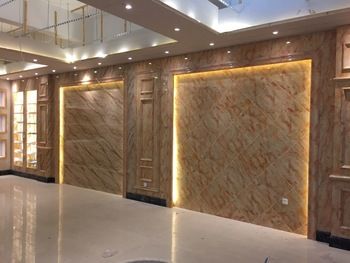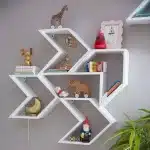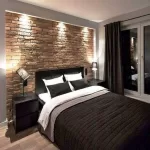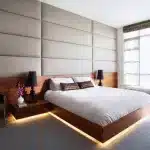Interior A to Z in Gurgaon
Our cohesive team of architects, interior designers, and civil engineers can successfully translate the client’s ideas into projects that are appealing to the eye and profitable from a business standpoint. Our clients benefit from the integrity of our designs and implementations. From “idea to completion,” we work.
Interior A to Z is an effort to alter the rules of the game. The architects and interior designers who create stunning spaces for us to live and work in deserve more praise and prominence. We are hopeful that this would affect how their potential customers view them and enable them to gain more popularity and revenue.
We are prepared to handle interior design jobs of any size, from modest improvements to extensive ones. From procurement and budget management to execution, we offer full project management support. We perform work for residences, workplaces, hotels, restaurants, hospitals, and other commercial buildings.
We want to give the design community a high-tech platform so they may establish their brand, do business in line with global trends, and take advantage of never-before-seen offers from manufacturers and vendors. Whether the client prefers an ultra-modern minimalistic look, a traditional ethnic look, rustic country style interiors, a soft feminine look, or occasionally a monochromatic single-color interior, we excel at creating the interiors to suit their tastes. We develop the designs according to how the client wants their interiors to be done in Gurgaon.
Our creative staff guarantees that you receive exceptional, personalized design solutions in Gurgaon, and our quality management methods guarantee that your project will be finished on time and within your desired budget.
We think that the best way to serve our clients is to listen to their ideas, thoughts, and aspirations, and then use our technological know-how, design know-how, and experience to make those dreams come true. We’re here to transform the way homeowners access architects, interior designers, contractors, and even design concepts. Whether you have a budget of Rs. 5000 or Rs. 5 crore, we hope you will discover ideas and expertise here to help you build the home of your dreams within that price range.
In the realm of architecture and interior design in Gurgaon, we have made a name for ourselves. We have over 300 completed projects and more than 15 years of experience in this industry. We have everything you need if you want your house to stand out from your neighbours’. You can include an opulent room and design high-end spaces by working with us. We are masters in the colorful simplicity and rich traditions of design.
In Gurgaon, one of the top architectural firms is Interior A to Z. They are regarded as the top interior design firms with offices in Gurgaon. When we work on your behalf, we assist you in finding your ideal property within your price range. When you sit back and unwind, we will set up your interiors, and you will be prepared to move into your new home. You can co-create with our designers and see them in 3D designs.
The best thing about Interior A to Z is how they apply sophisticated, well-thought-out interior customization that is unique. Our customers receive exactly what they have imagined, and the homes we construct are put through a rigorous quality check to guarantee safety, premium components, open pricing, and prompt delivery.
Our primary goal is to offer affordable alternatives for your dream house. The best part is that we relieve your tension and give your home everything you have ever desired since we have a team of the top interior designers and architects and because we have materials supplied by the most reliable vendors. Also, we communicate regularly during the process to solicit advice and lower the possibility of errors, which is why people in Gurgaon see us as the greatest interior designers.
Architecture
We construct homes in accordance with your dreams using stone, concrete, and wood. Artistic creation lies at the heart of Interior A to Z’ architectural services. We provide you designs of the highest caliber thanks to the greatest interior designers in Gurgaon. To ensure the project is delivered on schedule, our personnel regularly visit the sites.
Since Interior A to Z offer high-quality service and have a creative team of designers and a knowledgeable team of architects, working with them is highly profitable for clients. At Interior A to Z, we construct cost-effective designs while providing you with the greatest design in the shortest amount of time. The top architects in Gurgaon are at your disposal, and the plus point is vastu-oriented home designs.
Interior Design
You discover that you are residing in an interior design and architectural universe when you glance around where you are sitting. The greatest interior designer in Gurgaon can be found by consulting Interior A to Z if you are moving or renovating. We are a group of talented individuals with knowledge of tools, space, and color. To make your place stand out, we also redesign and restore it. We at Interior A to Z take care of the flooring, paints, wall coverings, drapes, and light fittings.
Landscape
We established the field of inexpensive landscaping work in Gurgaon. Our team of experts in landscape design and development integrates art and nature. We at Interior A to Z are the ideal combination of modern designers, bridging the gap between landscape architecture and garden design. Both the front and rear yards are created by us. Thanks to great landscape architecture, recreation and relaxation are now more enjoyable. Also, your home’s worth rises. We design everything, even sprawling lawns and urban development’s.
Innovators creating Smarter solutions
Due to our efforts to satisfy our clients’ needs and go above and beyond their expectations, Interior A to Z is regarded as one of the top architectural firms in Gurgaon. We continue to strike the ideal mix between gorgeous design and usefulness. We create luxurious locations where people want to live, work, and spend time with their loved ones.
The Interior A to Z have altered the architecture, interior design, and skyline of the buildings. Both residential and commercial projects are something we can tackle. Our team is passionate about perfection and designing rooms with the proper proportion and beauty. We adhere to deadlines as well.
HOME INTERIOR
In accordance with the preferences and personalities of our clients, we provide extremely original and contemporary residential interior design with a classic touch.
Our experts work hard to turn a vacant flat or single-family home into a person’s dream residence. Our decorators respect the given space and work to make the best use of it while adhering to client specifications and industry standards. Also, we are experts at creating and embellishing kid’s rooms with a theme.
Architectural Drafting for Homes
Our cohesive team of architects, interior designers, and civil engineers can successfully translate the client’s ideas into projects that are appealing to the eye and profitable from a business standpoint. Our clients benefit from the integrity of our designs and implementations. From “idea to completion,” we work.
Kitchen Designing
Our goal is to provide every Indian with a dream kitchen. To constantly produce cutting-edge products and advance design, innovation, and improvement. Due to our experience in the modular kitchen sector, we have a deep understanding of consumer preferences. From affordable, creative kitchen solutions to simple kitchen installation, we uphold our reputation as industry experts. We specialize in providing kitchen solutions. We offer everything you need, from culinary utensils to appliances, to turn your kitchen into a professional kitchen.
COMMERCIAL INTERIOR
We are one of the top interior designers with experience providing clients in Gurgaon and beyond with top-notch corporate interior design for small to medium-sized offices. Around 100,000 square feet of interior work have been completed by us in the past two years. We have highly skilled and experienced architects and designers who provide the corporate sector with first-rate interior design services while keeping current trends and modern design in mind. Our designers’ primary concern is balancing optimal comfort with maximum space planning.
3D Floor Designer
We are experts in 3D modeling, 3D photo-realistic rendering, 3D walkthrough animation, and 3D architectural rendering. We collaborate with people and companies of all sizes to realize ideas through careful client-focused design approaches.
3D Room Designer
We offer professional 3D architectural rendering and architectural modeling rendering services at Architectural 3D Rendering. We now have the chance to continue meeting the demands of a global market thanks to our commitment to quality and execution.

















